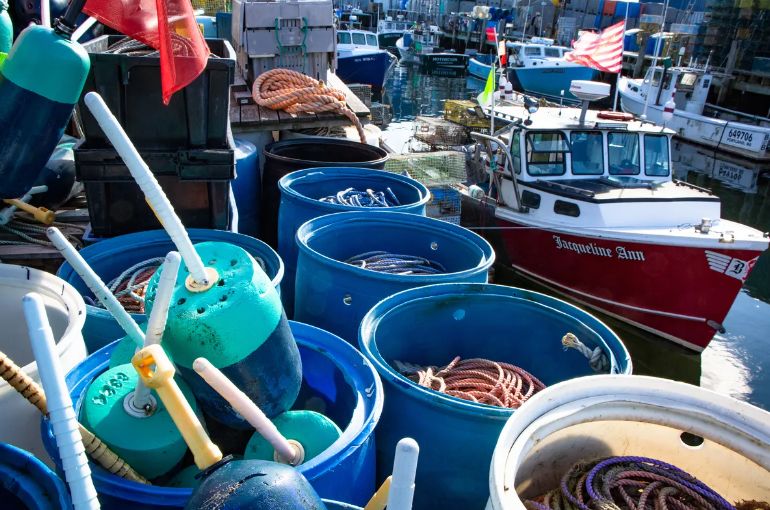Many of Maine’s commercial marine fisheries have experienced notable highs in the past decade with lobsters, softshell clams and baby eels all hitting record annual harvest values.
But when it comes to 2022, the statewide fisheries harvest total stands out for a different reason: a record low.
At 197 million pounds for all commercially harvested marine species, 2022 was the first time since 1975 that Maine’s reported annual seafood harvest has fallen short of 200 million pounds. In fact, the cumulative volume of Maine’s commercial fisheries dropped by more than 120 million pounds between 2012 and 2022, state data show.
Patrick Keliher, head of the state’s Department of Marine Resources, said there are myriad reasons why fishery landings have declined — some regulatory, others environmental.
Some fisheries are well below their former harvest totals. Northern shrimp have migrated north out of the Gulf of Maine because of climate change, urchins were significantly overfished in the 1990s and the harvest of baby eels has been restricted to offset habitat loss. Softshell clams, which reached a record high harvest value in 2021, had their lowest-ever documented total harvest by volume in 2022.
Meanwhile, landings of lobster, which remains the state’s dominant fishery despite looming restrictions to better protect whales, have dipped in recent years but still are much higher than they were prior to the 1990s.
But by far the biggest drop has been in the fishery for herring, a fish that remains the preferred bait for many lobstermen. Regulatory catch limits on herring have been severely reduced over the past decade, causing landings of the species to plummet nearly 96 percent, from more than 92 million pounds in 2012 to less than 4 million last year.
Keliher, who’s worked for the department since 2007, said that tremendous drop in herring volume will be difficult to regain, either with herring or other species, and that trying to squeeze fisheries for maximum yield is “a thing of the past.”
Even with that decline in volume, however, the overall value of Maine’s statewide seafood landings has increased by $43 million in the past decade, and by more than half a billion dollars since 1975, which has helped Mainers who fish for a living to absorb higher prices for fuel, bait, equipment and other costs of doing business.
But the decline in volume — at a time when the planet’s population recently surpassed 8 billion people and the global demand for seafood is expected to continue to grow — raises questions about the future of Maine’s seafood industry.
Maine’s commercial fisheries must be managed for long-term sustainability, Keliher said. This means being prepared for dips and declines in harvest volumes and trying to add value to the fisheries with marketing and by boosting in-state processing capacity.
It also means broadening fisheries management to look at ecosystems, rather than managing species independently from each other, he said. Seaweed, crabs, scallops, lobster and other species often occupy the same habitat during certain times, he said, and so the impact of one species on another needs to be considered.
“Ecosystem management is growing,” Keliher said. “It’s about wanting a stable level of harvest.”
There’s also opportunity for species not widely fished for in Maine.
If Maine can help build consistent market demand for species like flounder, pollock or monkfish, all of which are readily available in the Gulf of Maine, and fish them sustainably, it can help boost Maine’s seafood production, said Ben Martens, executive director of the Maine Coast Fishermen’s Association. There’s been success in boosting the market for Maine scallops with direct marketing by fishermen and retailers to consumers, and other fisheries can similarly benefit, he said.
“We need to find homes for our fish,” Martens said. “You’ve got to tell the story and get people to come to you. There’s nothing more real in Maine than seafood.”
Stable markets are a key part of maintaining Maine’s fisheries, Martens said. Low harvest volumes of certain species might not be a matter of low supply or rigid government restrictions, he said. It might be that fishermen don’t want to pursue species that don’t pay well.
Flounder, he said, is a good example. Regulators have significantly increased catch quotas for flounder, which was heavily fished in the mid-1980s, but Maine fishermen aren’t targeting flounder because market demand is low and seafood buyers are offering low prices for the fish.
“We have an abundance of flounder in our oceans,” Martens said.
Despite the overall volume drop, there has been an upward trend among some Maine seafood, specifically those cultivated through aquaculture. Annual harvests of oysters and seaweed have increased significantly over the past 20 years, though Maine’s oyster output also may be benefitting from warming ocean temperatures.
It’s unclear if farmed salmon production is increasing in Maine, because the only company, Cooke Aquaculture, currently growing salmon in Maine considers it confidential information. However, Maine’s volume of farmed fish is expected to grow as more farms set up shop along Maine’s coast.
Keliher said that there is room for continued growth for aquaculture in Maine, but emphasized that it must be done in such a way that doesn’t harm the environment or adversely affect coastal communities. He said that there are less than 1,400 acres of leased aquaculture sites on Maine’s coast, even though the state has more than 3,000 miles of shoreline, including islands.
“Maine is held up as an example on how to do this,” Keliher said of mitigating aquaculture’s impacts and denying proposals that would be too intrusive on nearby property owners or people who spend time on the water. “We have to balance all these other needs.”
Maintaining Maine’s fishing infrastructure also is critically important to preserving the industry and in making sure the state’s fisheries have room to grow, both Keliher and Martens said. As Maine’s real estate market has caught fire in the wake of the COVID-19 pandemic, it has put pressure on working waterfront property owners to sell their wharves or warehouses to developers.
“We can’t lose that. We can’t become southern New England,” Keliher said. “That threat of conversion the past few years has been really high.”




